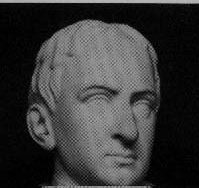|
 Roger
Cotes accomplishments and life can be summed up as a great case
of might have been. Cotes contributions to modern computational
methods, lie heavily in the fields of astronomy and mathematics.
Cotes began his professional educational career with a particular
focus on astronomy. He became a Fellow of the Trinity College
of Cambridge in 1707 and at age 26 he became the first Plumian
Professor of Astronomy and Experimental Philosophy. On his appointment
to professor, he opened a subscription list in an effort to provide
an observatory for Trinity. Unfortunately, the observatory was
never finished in Cotes lifetime and was demolished in 1797. Astronomy
continued to fascinate Cotes, driving him to, in correspondence
with Isaac Newton, to design a heliostat telescope with a mirror
revolving by clockwork. He recomputed the solar and planetary
tables of J.D. Cassini and Flamsteed, and he intended to create
tables of the moon's motion, based on Newtonian principles. Finally,
in 1707 he formed a school of physical sciences at Trinity in
partnership with William Whiston. Roger
Cotes accomplishments and life can be summed up as a great case
of might have been. Cotes contributions to modern computational
methods, lie heavily in the fields of astronomy and mathematics.
Cotes began his professional educational career with a particular
focus on astronomy. He became a Fellow of the Trinity College
of Cambridge in 1707 and at age 26 he became the first Plumian
Professor of Astronomy and Experimental Philosophy. On his appointment
to professor, he opened a subscription list in an effort to provide
an observatory for Trinity. Unfortunately, the observatory was
never finished in Cotes lifetime and was demolished in 1797. Astronomy
continued to fascinate Cotes, driving him to, in correspondence
with Isaac Newton, to design a heliostat telescope with a mirror
revolving by clockwork. He recomputed the solar and planetary
tables of J.D. Cassini and Flamsteed, and he intended to create
tables of the moon's motion, based on Newtonian principles. Finally,
in 1707 he formed a school of physical sciences at Trinity in
partnership with William Whiston.
From
1709 to 1713, Cotes became heavily involved with the second edition
of Newton's Pricipia, a book that explained Newton's theories
on universal gravitation. Newton's first edition of Pricipia had
only a few copies printed and was in need of updating and revision
to include Newton's works and principles of lunar and planetary
theory. Newton at first had a casual approach to the revision,
since he had all but gave up scientific work. However, through
the vigorous passion displayed by Cotes efforts, Newton's scientific
hunger was once again reignited. The two spent nearly three and
half years collaborating on the work, in which they fully deduce,
through Newton's principles, the theory of the moon and the equinoxes,
as well as, the theory of comets and their orbits. The total number
of works printed for this addition was limited to 750 copies.
However, a pirate copy from Amsterdam met all other demand. As
reward to Cotes, he was given a share of the profits and 12 copies
of his own. Cotes' original contribution to the work involve a
preface with supported the scientific superiority of Newton's
principles over the then popular idea of vortices presented by
Descartes. Cotes concluded that the Newton's law of gravitation
was confirmed by observation of celestial phenomenon and did not
depend on unexplained occult forces which Cartesian critics alleged.
Cotes'
major original work was in mathematics, especially in the fields
of integration calculus methods, logarithms, and numerical methods.
Cotes' published only one paper in his lifetime, entitled Logometrica,
in which he successfully constructs the logarithmic curve. After
his death, many of Cotes' mathematical papers were hastily edited
by Robert Smith and published in Harmonia mensurarum. Cotes additional
works were later published in Thomas Simpson's The Doctrine and
Application of Fluxions. Although, Cotes' style was somewhat obscure,
Cotes' systematic approach to integration and mathematical theory
was highly regarded by his peers. Cotes had discovered an important
theorem on the nth roots of unity, foresaw the method of least
squares, and he discovered a method for integrating rational fractions
with binomial denominators. Furthermore, Cotes was praised for
his efforts in numerical methods, especially in interpolation
methods and his table construction techniques.
Cotes
untimely death from a violent fever, coupled with the added decline
in British mathematics as the time, have lead many to remember
Cotes as one of the few British mathematicians capable of following
the powerful work of Sir Isaac Newton. Cotes' drive and intuition
lead Newton to say If he had lived we would have known something.
Home >
Biographies
|